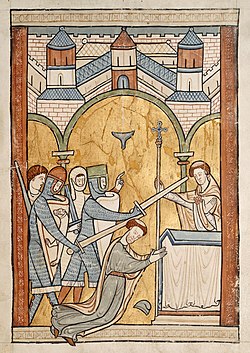
Sir Richard le Breton or Richard de Brito [1] (fl. 1170) was one of the four knights who in 1170 murdered Thomas Becket, Archbishop of Canterbury.

Sir Richard le Breton or Richard de Brito [1] (fl. 1170) was one of the four knights who in 1170 murdered Thomas Becket, Archbishop of Canterbury.
Roger Brito is listed in the Domesday Book of 1086 as holding land under the overlordship of the Church of Long Sutton in Somerset, in which county the family was later seated at Sampford Brett (alias Sandford-Bret). During the reign of King Henry I (1100–1135) Sampford Brett was held by Simon le Bret, from the feudal barony of Dunster by military service of half a knight's fee. [2] He served in the household of Henry II's brother William, Count of Poitou [ citation needed ] and was a near neighbour of the FitzUrse family of Williton in Somerset,[ citation needed ] a member of which family was another of the assassins of Thomas Becket. Simon le Bret had two sons: Richard Brito, one of the assassins of Thomas Becket and Edmund le Bret, who adopted the surname de Sandford from his seat. [3] William the Conqueror granted a manor in the eastern part of the parish of Great Stambridge in Essex and another in Sanford in Somerset to a Norman named Auvrai Le Breton following the Norman conquest of England. A later relative, Simon Le Breton, had two sons, Richard and Edmund, who inherited their share of Sanford and Great Master Bridge. Both were part of the royal court of King Henry II; in particular Richard Le Breton was a close friend of the king's brother, Prince William.
During the attack on Becket in 1170 by the four knights, Sir Reginald Fitzurse, Sir Hugh de Morville, Brito and Sir William de Tracy, Brito is said to have broken his sword when striking at Becket's head.
According to Edward Grim:
... But the third knight inflicted a grave wound on the fallen one; with this blow he shattered the sword on the stone and his crown, which was large, separated from his head so that the blood turned white from the brain yet no less did the brain turn red from the blood; it purpled the appearance of the church with the colours of the lily and the rose, the colours of the Virgin and Mother and the life and death of the confessor and martyr...
He shouted "Take that, for the love of my lord William, the king's brother!" when he delivered the fatal blow. [4] It was believed by William's friends that the count had died of a broken heart after Thomas Becket refused to allow his marriage.
After the assassination the four knights fled to Scotland and from there to Knaresborough Castle in Yorkshire. All four were excommunicated by the Pope Alexander III at Easter in 1171 and ordered to undertake penitentiary pilgrimages to the Holy Land for 14 years. [5]
Brito eventually retired to the island of Jersey.[ citation needed ] A ledger stone for one of the le Bretons of Jersey survives in St Thomas's Church in Salisbury. The Brett family of Whitestaunton in Somerset are said by the Duchess of Cleveland to be descended from the Brettes of Sampford Brett, and are the ancestors of the present Brett family, Viscounts Esher.[ citation needed ]
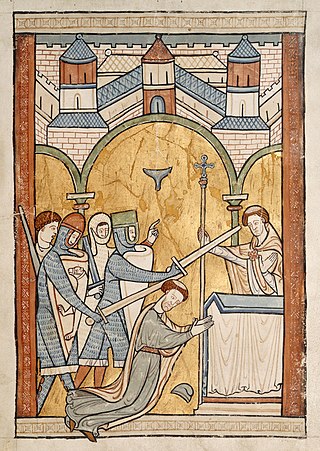
Thomas Becket, also known as Saint Thomas of Canterbury, Thomas of London and later Thomas à Becket, served as Lord Chancellor from 1155 to 1162, and then notably as Archbishop of Canterbury from 1162 until his death in 1170. He engaged in conflict with Henry II, King of England, over the rights and privileges of the Church and was murdered by followers of the King in Canterbury Cathedral. Soon after his death, he was canonised by Pope Alexander III. He is venerated as a saint and martyr by the Catholic Church and the Anglican Communion.

Sir William de Tracy was a knight and the feudal baron of Bradninch, Devon, with caput at the manor of Bradninch near Exeter, and was lord of the manors of Toddington, Gloucestershire and of Moretonhampstead, Devon. He is notorious as one of the four knights who assassinated Thomas Becket, Archbishop of Canterbury, in December 1170.
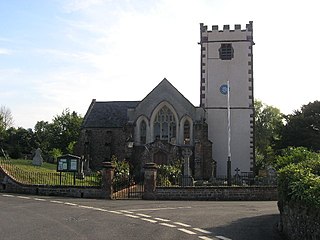
Sampford Brett is a village and civil parish situated at the south-western edge of the Quantock Hills, Somerset, England, less than 1 mile (1.6 km) south of Williton, just off the A358 road to Taunton.
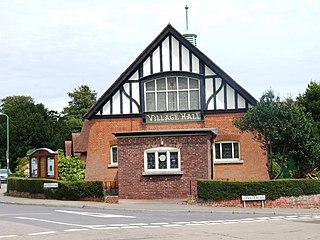
Saltwood is a village and civil parish in the Folkestone and Hythe District of Kent, England. Within the parish are the small hamlets of Pedlinge and Sandling.

Sir Reginald FitzUrse (1145–1173) was one of the four knights who murdered Thomas Becket in 1170. His name is derived from Fitz, the Anglo-Norman French term meaning "son of" and urse meaning a bear, likely the nom de guerre of an ancestor. Although he lived before the true age of heraldry, which developed in the early 13th century, his shield bore the cognizance of a bear, which is visible in a contemporary drawing portraying the murder of Becket.

Sir Hugh de Morville was an Anglo-Norman knight who served King Henry II of England in the late 12th century. He is chiefly famous as one of the assassins of Thomas Becket, Archbishop of Canterbury in 1170. He held the title Lord of Westmorland and of Knaresborough; his father was Hugh de Morville, Constable of Scotland.
Events from the 1170s in England.
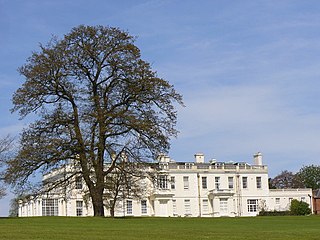
Barham Court is an English country house in the village of Teston, Kent.
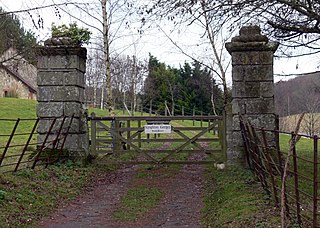
Knighton Gorges Manor was one of the grandest manor houses on the Isle of Wight, located in the hamlet of Knighton, near Newchurch.
Reginald de Warenne was an Anglo-Norman nobleman and royal official. The third son of an earl, Reginald began his career as an administrator of his brother's estates, and continued to manage them for his brother's successor, William, the second son of King Stephen. Reginald was involved in the process that led to the peaceful ascension of Henry fitzEmpress to the throne of England in 1154 and served the new king as a royal justice afterwards. He played a minor role in the Becket controversy in 1170, as a member of the party that met Becket on his return to England from exile in 1170.
Ranulf de Broc was an Anglo-Norman nobleman and royal official during the reign of King Henry II of England. He held two offices in the royal household as well as performing other administrative duties for the king. During the Becket controversy between King Henry and Thomas Becket, the Archbishop of Canterbury, de Broc supported the king and was granted the administration of the exiled archbishop's lands during the later half of the 1160s. This earned de Broc three sentences of excommunication from the archbishop because of de Broc's financial exactions from the estates. De Broc was with the four men who murdered Becket in December 1170, although he did not take part in the actual murder. At de Broc's death around 1179, he left behind a widow and five daughters, who were his co-heiresses.
Clarembald was a medieval Benedictine monk and abbot-elect of St Augustine's Abbey in Canterbury, Kent.

Sir John Sully, KG, of Ruxford and Iddesleigh in Devonshire, was an English knight. He was one of the many deponents who gave evidence in Scrope v Grosvenor, one of the earliest heraldic law cases brought in England, at which time he stated his age as 105. In about 1362, he was appointed by King Edward III as the 39th Knight of the Garter.

Baron St Maur was a barony created by writ in 1314 for the soldier Nicholas de St Maur, of Rode in Somerset.
Walter I Beke, of Eresby in the parish of Spilsby in Lincolnshire, was a prominent Anglo-Flemish landholder.
Richard FitzUrse was an Anglo-Norman nobleman and feudal baron of Bulwick in Northamptonshire.
Sibyl of Falaise was a kinswoman of King Henry I of England. She was possibly his illegitimate daughter or a niece, as the sources are unclear. Another possibility is that she may have been more distantly related to him instead. She married and had at least one daughter, although her husband's other children may possibly be her offspring also. Through her daughter, Sibyl was the grandmother of Reginald fitzUrse, one of the murderers of Thomas Becket.

"Will no one rid me of this turbulent priest?" is a quote attributed to Henry II of England preceding the death of Thomas Becket, the Archbishop of Canterbury, in 1170. While the quote was not expressed as an order, it prompted four knights to travel from Normandy to Canterbury, where they killed Becket. The phrase is commonly used in modern-day contexts to express that a ruler's wish may be interpreted as a command by his or her subordinates. It is also commonly understood as shorthand for any rhetorical device allowing leaders to covertly order or exhort violence among their followers, while still being able to claim plausible deniability for political, legal, or other reasons.
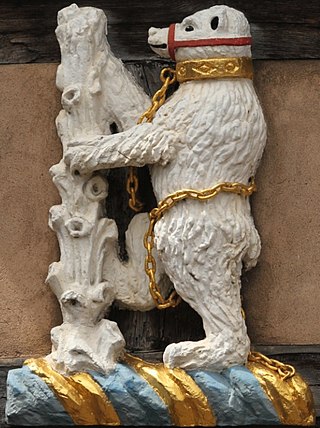
The Bear and Ragged Staff is a heraldic emblem or badge associated with the Earldom of Warwick.